Mills Mess
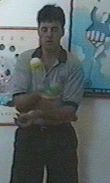
The following article first appeared in the Jan/Feb 2000 issue of JUGGLE magazine. The publisher has kindly given permission to reproduce it here.
For economy, the article and illustrations refer to bean bags that are colored black, white, and striped black and white. The animated GIF files are in color, however. Hope this isn't too confusing.
Steve Mills is a master at his Mess. Many thanks for him for taking the time to demonstrate this pattern for the rest of us. Folks who would like to see a slower version, where the U-ball flight path is more obvious may want to check out this page.
Todd Beck is the illustrator.
Mills Mess, named after Steve Mills, is one of the more elegant three ball variations. For many the ability to juggle this pattern is a milestone of sorts, marking an important distinction between a beginner and a more advanced practitioner.
The throwing sequence is the standard right, left, right, left alternating between the hands. There are three different throwing positions for each hand in a Mills Mess. For clarity, a distinctly colored ball is assigned to each of the hand positions and its type of throw. The color of the ball, hand position, and type of throw are the following:
1) throw the white ball in an overhand crossed arm reverse cascade with the top hand;
2) throw the striped ball with an underhand reverse cascade with the hand that is on the bottom of crossed arms; and
3) throw the black ball in a regular reverse cascade with uncrossed arms.
Since both hands each have three different positions in which to throw a ball, you must juggle a total of six throws to run through a complete cycle of Mills Mess.
Each ball also has its own flight path for a Mills Mess. When done well, the three paths mesh such that the three balls resemble a twisting snake that writhes back and forth among your hands. Many jugglers appreciate the one, two, three, one, two, three back and forth rhythm of the balls changing direction. The constant crossing and uncrossing of the arms becomes a fluid motion that adds to the beauty of this trick.
People learn to juggle a Mills Mess in many ways. One approach is to understand and make sure that all the balls are following their proper flight paths. As a warm up to learning Mills Mess, first try throwing each ball individually. Jugglers ready to jump right in with all three balls may want to skip down to the Putting the Three Throws Together section below.
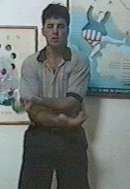
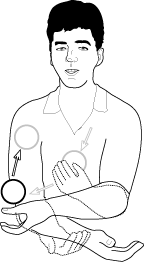
White Ball
(animation shows green ball)
The white ball utilizes a series of crossed arm reverse cascade throws. Put the white ball in your right hand and cross that hand over the left. Continue carrying the ball to the outside left of the pattern and throw it back into the center. While the ball is in the air cross your arms the other way so your left hand is on top. The left hand catches the white ball on the right side, just after the left hand crosses over the right. After the left hand catches the ball, carry it to the outside right of the pattern and throw it back into the center. Cross your arms so the right hand is on top. Catch the white ball in your right hand after this hand crosses over the left hand to the left side of the body.
The white ball makes an infinity sign as you throw it from hand to hand. It may be tempting, but resist the urge to pull the white ball back and throw it on the same side of the body. The throw always comes after the hand has carried the white ball to the opposite side of the body.
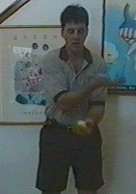
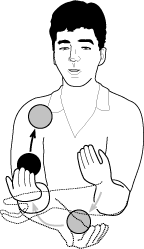
Black Ball
(animation shows yellow ball)
The black ball is a series of regular reverse cascade throws. This ball also describes an infinity sign as it flies from hand to hand. What makes this throw tricky is that you catch the black ball when the catching hand is crossed underneath the other hand. The hands are open up for the throw, however.
Place the black ball in your left hand and toss a reverse cascade throw with that hand. After the throw keep moving your now empty left hand clockwise so your arms are crossed with the left hand on top and the right hand is underneath. Catch the black ball in your right hand with your arms still crossed. Swing your right hand down and to the right to open your arms and throw the ball with a reverse cascade to the left. Keep swinging the empty right hand in a counterclockwise direction after the throw so it ends up crossed over the left. Catch the ball in your left hand while the left hand is crossed underneath and swing to the left to repeat.
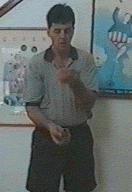
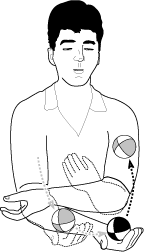
(animation shows blue ball)
The striped ball travels mostly underneath the other two balls in its own, special U-shaped pattern. Take this ball and throw it back and forth so it describes the letter U. The right hand crosses underneath the left and throws the ball straight up on the left side. (Later on, as you become more accomplished, you will want to throw this ball slightly into the middle of the pattern.) Uncross your arms so the left hand can catch the striped ball on the left side of the pattern. The left hand then crosses under the right hand and throws the ball straight up on the right side of the pattern. Open your arms again so the right hand can catch the striped ball while your arms are uncrossed.
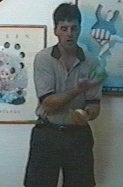
In one sense, the white and black balls share the same flight path. They both travel mostly in the top half of the pattern and describe a sideways figure eight or an infinity sign. Both balls are also thrown by a series of reverse cascade throws. However, the white ball is always thrown when the arms are crossed and the black ball is always thrown when the arms are uncrossed. Another distinction between the two is that the white ball is caught by a hand that is crossed over the other hand, while the black ball is caught with the hand that is crossed under the other hand.
Many jugglers on the verge of mastering Mills Mess forget to carry the white ball over to the opposite side of the body. After catching this ball, there is a strong tendency to bring it back to the same side of the body for the throw. Resist this urge to pull the white ball back to the same side by continuing the movement of the hand across the body before throwing it. Remember, throw the white ball as an overhand crossed arm reverse cascade throw from the outside to the inside of the pattern.


Putting the Three Throws Together
Begin with the white and striped balls in the right hand and the black ball in the left hand. Cross your right arm over your left. From the outside left of the pattern, throw the white ball back into the center with an overhand crossed arm reverse cascade throw. Uncross your arms as your left hand throws a reverse cascade from the left into the center. Continue the clockwise arm motion so your right hand is crossed underneath the left, and throw the striped ball in an underhand crossed arm reverse cascade throw from the outside left into the center. You have just completed one half of a Mills Mess. Now it's time to go the other direction.
The sequence for the next three throws can be thought of as a mirror image of the first three. The left hand caught the white ball on the right side just after the left arm crossed over the right. The left hand carries the white ball to the outside right and throws an overhand crossed arm reverse cascade throw back into the center. The right hand catches the black ball, while the right arm is crossed underneath the left, and carries the black ball to the right side to throw a reverse cascade with the arms open. Continuing the counter-clockwise rotation, the left hand catches the striped ball with the arms uncrossed and carries the striped ball underneath the right arm to throw in an underarm reverse cascade throw from the right to the center.
You have just completed all six throws and are ready to begin the sequence again. The order in which the balls are thrown is white, black, stripe, white, black, stripe, over and over. Don't forget that you are alternating right and left hands while throwing in this sequence. Looking at just the right hand the throwing sequence is white, striped, black, white, striped, black.
Good luck. Once you can juggle a Mills Mess, you are ready to learn even more advanced patterns.
copyright 2000 by Todd Strong

- Home
- About
- Ball Juggling
- Cigar Boxes
- Club Juggling
- Club Swinging
- Comedy Writing
- Cup Stacking
- Devil Sticks
- Diabolo
- Diabolo Postcards
- Dice Stacking
- Hat Manipulation
- Lasso
- Miscellanous Juggling
- Parachute Games
- Poi Swinging
- Ring Juggling
- Shaker Cups
- Skill Games
- Staff
- Tennis Balls and Can
- New Games Foundation
- Ordering and Shipping
- Contact Information
- Peeps (photos of birds and stuff)
- Personal Thoughts
- Workshops
- Links
- Questions? Comments? Feedback?